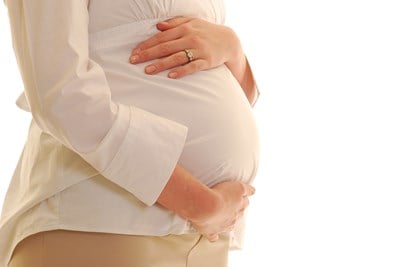Preeclampsia is a hypertensive disorder, the prelude to eclampsia, that occurs in pregnant women. Preeclampsia generally begins to show signs around the 20th week of pregnancy. Without treatment, it can lead to serious complications for both mother and baby. Diagnosis requires high blood pressure in tandem with at least one other significant symptom. Here’s a look at the causes and risk factors, symptoms, and complications of preeclampsia.
Causes of Preeclampsia
The cause of preeclampsia is largely considered to be a combination of different factors, although it isn’t completely understood. According to the Mayo Clinic, the potential for preeclampsia may start with the development of the placenta. Rather than forming the appropriate blood vessels needed to provide the placenta (and thus the fetus) with nutrients, the blood vessels appear to be narrow and “react differently to hormonal signaling,” preventing blood from flowing to the placenta as it should. Exactly why these blood vessels develop abnormally may be due to uterine blood flow, blood vessel damage, immune system issues, or genetic differences.
Other experts suggest the cause is dual natured. Not only is the blood vessel development present, but certain lifestyle factors might contribute to the development of preeclampsia at the same time -- particularly the presence of preexisting conditions that affect the vascular system.
Risk Factors of Preeclampsia
There are a number of risk factors associated with preeclampsia. The risk of preeclampsia is greater for women who've had a diagnosis of preeclampsia during a previous pregnancy, are currently pregnant with multiples (twins, triplets, etc), have different partners for different pregnancies, become pregnant again within less than two or more than 10 years difference, or became pregnant using in vitro fertilization. Women who are less than 17 years or over 40 years old are also more likely to develop preeclampsia. Additional risk factors are based largely on maternal health factors prior to conception. The presence of the following health conditions before pregnancy lead to a heightened chance of developing preeclampsia:
- Obesity
- Diabetes
- Kidney disease
- Chronic hypertension
- Lupus
- Autoimmune diseases (including rheumatoid arthritis)
- Migraines
- Blood clots
Symptoms of Preeclampsia
Hypertension (high blood pressure) is probably the single most important diagnostic factor of preeclampsia -- even women with no prior history of high blood pressure may develop it. Problems with at least one other organ system must also be apparent.
Additional symptoms may include protein in the urine, kidney issues, headaches, and vision changes (blurring, loss, or photosensitivity). Other signs include acute abdominal pain on the right side under the ribs, vomiting, nausea, and urinating less than normal. Thrombocytopenia (low blood platelet counts) and poor liver function may be evident. Shortness of breath, weight gain, and swelling in the ankles are also signs of preeclampsia -- but these issues are also common in even the healthiest pregnancy.
Complications of Preeclampsia
The biggest concern of preeclampsia in regard to a developing infant is the abnormal blood vessels in the placenta. Maternal blood increases by as much as 50% during pregnancy to provide more oxygen and nutrients to the fetus. Additionally, severe preeclampsia may require inducing the infant’s delivery, particularly if the diagnosis is made much later in pregnancy. Mothers with preeclampsia have an increased risk of giving birth prematurely, and because of the blood-flow interference, fetal growth restriction may lead to a low birth weight.
Preeclampsia may also cause placental abrasion, leading to heavy bleeding when the placenta pulls away from the uterine wall, which can be fatal for both mother and infant. Furthermore, preeclampsia can evolve into HELLP syndrome or eclampsia. HELLP is hemolysis, elevated liver enzymes, and low platelet count, and can result in damage of many organ systems. Eclampsia is characterized by maternal seizures, which can be extremely dangerous for both lives.
Treating preeclampsia that presents early in pregnancy typically requires a combination of pharmaceutical interventions. The most common and effective means of treatment, however, is delivery. If you suspect you have preeclampsia, talk to your obstetrician or midwife immediately.



